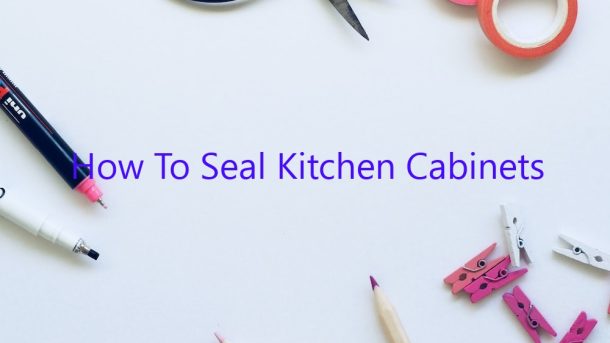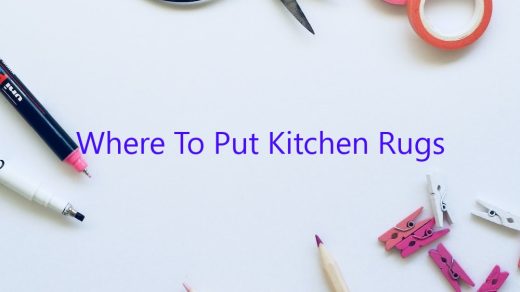If you’ve just finished painting your kitchen cabinets, or you’ve just installed new ones, you’ll want to seal them to protect the new finish. Cabinet sealers come in both water- and oil-based formulas, and both types are available in aerosol cans or in liquid form.
Water-based sealers are the easier of the two to apply, and they’re also the safer option if you have children or pets. They’re available in both matte and glossy finishes, and they’ll protect your cabinets from water damage and stains.
Oil-based sealers are more durable than water-based sealers, and they’re also more resistant to scratches and fading. However, they’re more difficult to apply and they’re also more hazardous to use. They’re available in both matte and glossy finishes, and they’ll protect your cabinets from water damage, stains, and scratches.
To apply a sealer, start by cleaning the cabinets with a degreasing cleaner. Then, apply the sealer in a thin coat with a brush or a rag. Allow the sealer to dry for the recommended amount of time before applying a second coat.
Contents [hide]
What is the best sealer for kitchen cabinets?
What is the best sealer for kitchen cabinets?
When it comes to kitchen cabinets, there are many different types and finishes available. You may be wondering what the best sealer for kitchen cabinets is. In general, there are two types of sealers: oil-based and water-based.
Oil-based sealers are more durable and offer better protection against moisture and spills. However, they can also be more difficult to apply and may be more prone to streaks and smudges. Water-based sealers are easier to apply and are less likely to streak or smudge. However, they may not be as durable as oil-based sealers and may not offer as much protection against moisture and spills.
So, which sealer is right for you? It really depends on your needs and preferences. If you are looking for a durable sealer that offers maximum protection against moisture and spills, then an oil-based sealer may be the best option for you. If you are looking for an easy-to-apply sealer that is less likely to streak or smudge, then a water-based sealer may be the best option for you.
What do you seal kitchen cabinets with?
When it comes to cabinets, there are a few different types of sealant you can use. Polyurethane is a type of sealant that is usually clear and it is applied with a brush or a roller. It is a good choice for cabinets that will be used in a high-traffic area, such as a kitchen, because it is durable and resistant to stains and scratches. If you are looking for a sealant that is less durable, but will still provide some protection from spills and dirt, you may want to consider a sealant that is made from wax. Wax is a good choice for cabinets that will not be used in a high-traffic area, such as a bedroom, and it is easy to apply. Another option is to use a sealant that is made from a sealant that is made from a silicone-based product. Silicone-based sealants are ideal for cabinets that will be used in a moist environment, such as a bathroom, because they are resistant to water.
Do you put a clear coat on kitchen cabinets?
Do you put a clear coat on kitchen cabinets?
Many people choose to seal their kitchen cabinets with a clear coat of finish. This will protect the cabinets from scratches and water damage. There are a variety of clear coat finishes available, so you can choose the one that best suits your needs.
If you choose to seal your cabinets with a clear coat, be sure to follow the manufacturer’s instructions carefully. You may need to sand the cabinets before applying the clear coat. Also, be sure to allow the clear coat to dry completely before using the cabinets.
How do you protect freshly painted kitchen cabinets?
There are a few things you can do to protect freshly painted kitchen cabinets:
1. Wait at least 72 hours before putting anything near the cabinets. During this time, the paint will dry and be less likely to chip or scratch.
2. Use a soft cloth to clean the cabinets. Avoid using any harsh chemicals or cleaning products, as these can damage the paint.
3. Place a cabinet liner or shelf liner in the cabinets. This will help protect the paint from scratches and chips.
4. Install cabinet bumpers. These can help protect the cabinets from being hit or bumped.
5. Keep the cabinets away from heat sources. The heat can cause the paint to dry too quickly and may lead to chipping or cracking.
Should I put polyurethane over painted cabinets?
When it comes to painting cabinets, there are a few different routes you can go. You can paint the cabinet doors and trim the same color, or you can paint them a different color. You can also choose to seal the paint job with a polyurethane to protect it from scratches and water damage.
Whether or not you should put polyurethane over painted cabinets depends on a few factors. If you have a good paint job, with no drips or streaks, you may not need to seal it with polyurethane. However, if you have any flaws in your paint job, it’s a good idea to seal it with a coat of polyurethane.
Another factor to consider is the type of paint you used. If you used a water-based paint, it’s a good idea to seal it with a coat of polyurethane. If you used an oil-based paint, you may not need to seal it with polyurethane, but it’s a good idea to test a small area to be sure.
If you decide to seal your painted cabinets with polyurethane, be sure to follow the manufacturer’s instructions. Usually, you’ll need to apply a few coats of polyurethane for adequate protection.
Do you have to put a topcoat on painted cabinets?
Do you have to put a topcoat on painted cabinets?
That’s a question that many homeowners have, and the answer is: it depends. If you are using a latex paint, you will likely need to put on a topcoat. If you are using an oil-based paint, you may not need to put on a topcoat, but it’s still a good idea to do so.
Topcoats protect your paint job from scratches and other damage, and they also help the paint to last longer. If you are using a latex paint, you should definitely put on a topcoat, as latex paint is not very durable. If you are using an oil-based paint, you may be able to get away with not putting on a topcoat, but it’s still a good idea to do so, as oil-based paint is not as durable as latex paint.
One thing to keep in mind is that if you are using a glossy paint, you will need to put on a topcoat, regardless of the type of paint you are using. Glossy paints are prone to scratches and other damage, and they also tend to fade over time.
If you are unsure whether or not you need to put on a topcoat, it’s always best to err on the side of caution and put one on. A topcoat only takes a few minutes to apply, and it can help to protect your paint job from damage.
Should inside of cabinets be sealed?
Should inside of cabinets be sealed?
Cabinets are a key part of any kitchen or bathroom. Not only do they provide storage, but they also can add visual interest to a room. When it comes to cabinets, there are a few things to consider in order to make sure they are functioning properly. One of these things is whether or not to seal the inside of the cabinets.
There are a few benefits to sealing the inside of cabinets. Sealing the inside can help to keep moisture and humidity out of the cabinets. This is important, especially in bathrooms, as it can help to prevent the growth of mold and mildew. Sealing the inside of cabinets can also help to keep bugs and other pests out of the cabinets.
There are a few things to keep in mind when sealing the inside of cabinets. One is that it is important to use a sealant that is specifically designed for cabinets. There are a few different types of sealants available, and it is important to select the one that is best for the cabinets. Another thing to keep in mind is that it is important to apply the sealant correctly. If the sealant is not applied correctly, it may not provide the desired results.
Overall, there are a few benefits to sealing the inside of cabinets. It can help to keep moisture and humidity out, as well as bugs and other pests. It is important to select the right sealant and to apply it correctly in order to get the best results.




